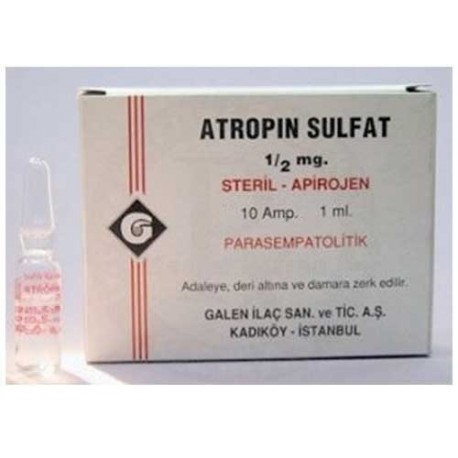 View larger
View larger Volume discounts
| Quantity | Discount | You Save |
|---|---|---|
| 2 | 5% | Up to $2.90 |
| 3 | 10% | Up to $8.70 |
| 4 | 15% | Up to $17.40 |
| 5 | 20% | Up to $29.00 |
More info
ATROPIN SULFATE BIOFARMA 1 mg / 1 ml ampoule It is administered intramuscularly, subcutaneously or intravenously.
1 ml of each ampoule;
•
Active ingredient
1 mg atropine sulfate,
•
Excipients
Contains sodium chloride and water for injection.
2. What is ATROPIN SULFAT BIOFARMA and what is it used for?
ATROPIN SULFATE is presented in boxes of 10 and 100 ampoules containing 1 mg of atropine sulphate in an ampoule. Ampoules contain a clear, colorless solution. ATROPIN SULFATE is used in the following situations;
- In bradyarrhythmias due to increased vagal activity (stimulation of the vagus nerve) (heart rate falling below 60 per minute),
- In eliminating vagal effects such as bradycardia, hypotension (decrease in blood pressure) and arrhythmias (rhythm disturbances) that may occur during surgery, as well as cardiopulmonary resuscitation,
- To reduce or prevent respiratory tract exudates during anesthesia (as a saliva reducing drug in pre-anesthesia treatment),
- Pylorus (the hole where the stomach opens into the duodenum), small intestine and large intestine spasms (contractions) (irritable bowel syndrome),
- Urethra (urinary tract) and biliary colic (pain due to inflammation of the gallbladder),
- It is used as an antidote (antidote) in the treatment of poisonous effects of cholinesterase inhibitors (such as neostigmine, pyridostigmine, pilocarpine), muscarine (in fungal poisoning of Inocybe and Clitocybe type) or organophosphate pesticides.
3.How to use ATROPIN SULFAT BIOFARMA?
Since ATROPIN SULFATE will be administered by your doctor or a healthcare professional, the following section is for your physician or healthcare personnel.
Instructions for proper use and dose / frequency of administration
• Dosage and frequency of atropine sulphate in the treatment of bradycardia arrhythmias vary depending on the severity of the condition.
In adults:
Common starting doses are 0.5 - 1.0 mg (0.5 - 1 ml) intravenously (i.v.).
In less severe cases, the total dose can be repeated up to 0.03 mg / kg (approximately 2 mg) (2 ml). The recommended dosage interval can range from 3-5 minutes to 1-2 hours.
In severe cases, a total dose of 0.04 mg / kg Click (approximately 3 mg) (3 ml) may be given.
Some experts recommend that this total dose should be divided into three (1 mg) at intervals of 3-5 minutes, while others prefer to apply a total dose of 3 mg as a single dose.
Pre-anesthetic medication: In order to reduce the risk of vagal inhibition of the heart and saliva and bronchial excretion before the induction of general anesthesia, 0.3 - 0.6 mg (0.3 - 0.6 ml) ATROPIN SULFATE, usually 30-60 minutes prior to anesthesia by subcutaneous (sc) or intramuscular (im) route. 0.5 mg) (0.5 ml) can be administered. Alternatively, the same dose can be administered i.v. just prior to induction of anesthesia. can be given as.
Gastrointestinal radiography: i.m. 1 mg (1 ml) is administered by route.
• As an antidote: s.c. in overdose treatment with parasympathomimetic agents. or i.m. 1-2 mg (1-2 ml) or i.v. Doses of up to 4 mg (4 ml) are used by way. In the treatment of irreversible anticholinesterase poisoning such as organophosphorus insecticides: Higher doses (at least 2-3 mg) may be required. These doses are repeated until the symptoms of cyanosis disappear or the heart rhythm reaches 80-90 beats per minute. Dosage intervals are adjusted according to the patient's heart rate. This application should be continued until definitive improvement occurs. This period can be 2 days or more.
In mushroom poisoning with rapid signs of intoxication, it should be administered in sufficient doses to control parasympathomimetic signs before coma and cardiovascular collapse appear.
Application route and method
ATROPIN SULFATE ampoules can be administered intramuscularly, subcutaneously or intravenously.
Different age groups
Use in children
In children younger than 12 years of age, 0.4 mg should generally not be exceeded.
• In the treatment of bradycardia arrhythmias:
0.01 - 0.03 mg / kg (0.01 - 0.03 ml / kg) is administered intravenously.
Preaesthetic medication:
By subcutaneous injection;
0.1 mg (0.1 ml) in babies up to 3 kg,
0.2 mg (0.2 ml) in 7-9 kg children,
0.3 mg (0.3 ml) in 12-16 kg children,
0.4 mg (0.4 ml) in 20-27 kg click children,
0.5 mg (0.5 ml) for 32 kg children
It is 0.6 mg (0.6 ml) in children weighing 41 kg. These doses are repeated every 4-6 hours when necessary.
Use in the elderly
Recommended dosage for adults is applied.
Special use cases
Kidney failure:
No data available.
Liver failure:
No data available.
If you have an impression that the effect of ATROPIN SULFATE BIOFARMA is too strong or weak, talk to your doctor or pharmacist.
If you use more ATROPIN SULFATE BIOFARMA than you should
Symptoms of overdose are marked sandy mouth accompanied by a burning sensation, difficulty in swallowing, hypersensitivity to light, flushing, dry skin, fever, rash, nausea, vomiting, heart palpitations and increased blood pressure. Due to the stimulation of the central nervous system, restlessness, tremors, confusion, exuberance, delusions and delirium may occur, followed by drowsiness.

